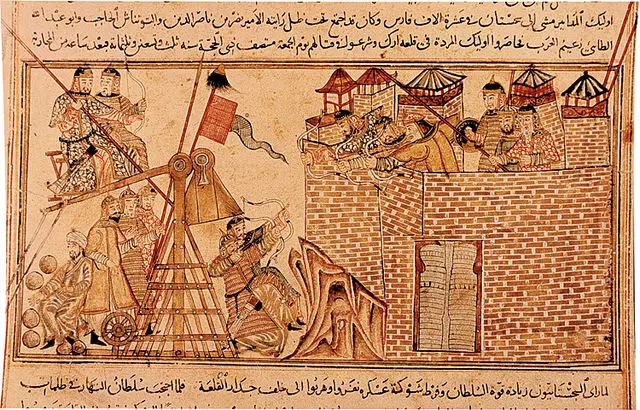
For nearly 1,700 hundred years the catapult was the most feared weapon of war across Europe. First appearing in the 4th century BC the catapult was designed to easily increase the effective range of armies to allow for prolonged sieges and engagements over defensive walls. Out of all the designs for catapults, there are 3 categories they all fit into.
Catapults changed how warfare was fought for over 1,700 years. There are 3 types of catapults in history. The first type is Ballistas. The second is onagers/mangonels. The third is the famous counterweight trebuchet.
Here at The History Ace, I strive to publish the best history articles on the internet. If in the end, you enjoyed this article then consider subscribing to the free newsletter and sharing around the web.
Without further ado, here is everything you will ever need to know about catapults and how they changed history forever.
The Catapult’s Creation: 399 BC
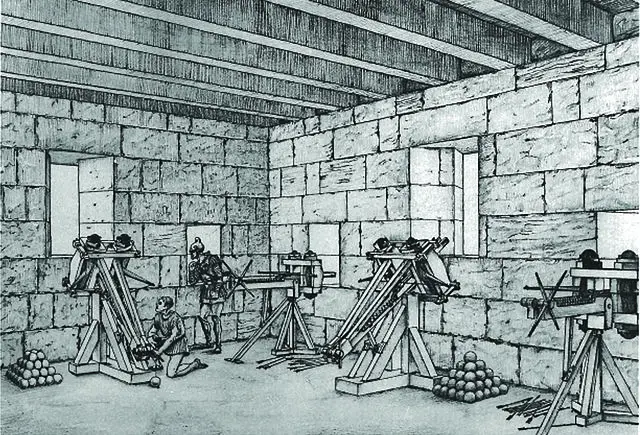
The first mentions of catapults in history appeared in Jeruselam in the 7th century BC. Historians have mentions of the ancient Judah King Uzziah installing giant machines that lobbed heavy stones on the walls of Jerusalem in the 8th century BC.
After appearing in Jerusalem we have reports of catapults in China and India however these are fragmentary and hard to place. Several historians have attempted to trace the history of the catapult back through these documents but not much has come of this as of yet.
However, mentions of these early catapult designs are only in passing. It is not until the ancient Greeks of the 4th century BC that we get accurate and in-depth descriptions of catapults. For many historians, this is considered the first use of the traditional catapult.
We get these descriptions of the catapult from the ancient Greek historian Diodorus Siculus. Siculus describes the siege of the island of Sicily in-depth and writes about mechanized long-range arrow throwers employed by the greeks.
These early catapults were not the long-range catapults of the middle ages. Instead, they were mechanized long-range crossbows capable of shooting an arrow much further than a typical bow. This was the first instance of a mechanized torque device being used to propel a missile in history. Today we call this ancient device a ‘catapult.’
The 3 Types of Catapults
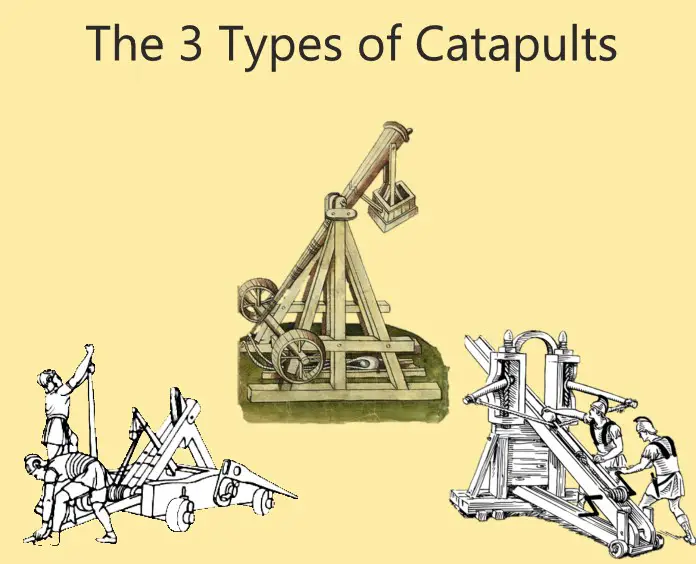
Throughout history there are 3 types of catapults that were used. Each of these catapults would build up potential energy through the use of a winch that was designed to slowly pull back a heavy string or fabric. When released this string or fabric would snap back to its original shape and send whatever object was in it flying forwards.
Catapult Type 1: The Ballista
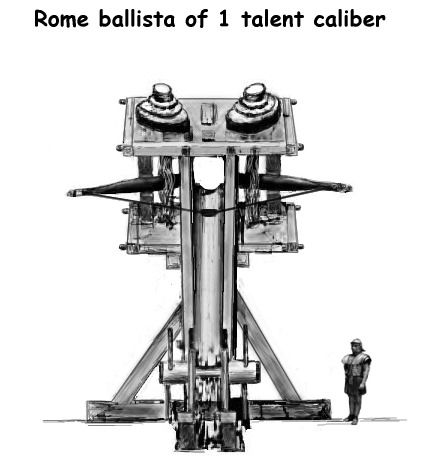
The first type of catapult used was the ballista. This siege engine looked like a giant crossbow and could effectively shoot a giant 50-150 lb object around 100 yards.
The ballista would be wound up with a team of soldiers rotating the winch at the bottom. This winch would slowly pull back and lock in a tightly wound string. In the middle of this string was a hopper object where you could place a giant bolt or stone.
Once the signal was given the winch would be released and the heavy object would go flying toward whatever the ballista was pointing at. These ballistas were not very accurate but could be easily assembled and when used in mass could instill terror into the enemy.
This is why the ballista was used as an anti-infantry device. The ballista team could easily impact an enemy far outside of the retaliatory range of a bow. The Romans loved these ballistas and gave them the affectionate name of tormentum or torment devices. This was because these ballistas could be easily set up and reign terror onto the Roman’s opponents who could do little to prevent it.
However, the ballista was only good against infantry soldiers. This was because against fortifications the heavy bolts or stones would simply bounce off making the machine worthless. To impact fortifications heavier catapults would have to be designed.
Catapult Type 2: The Onager/Mangonel
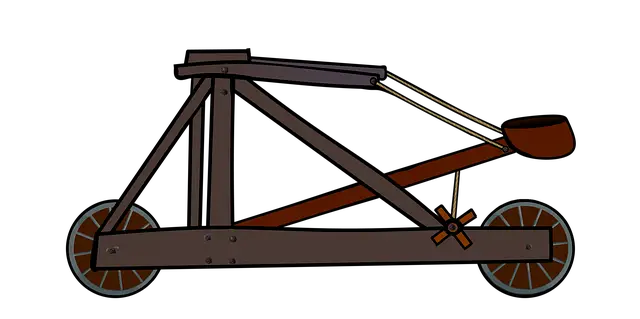
The second type of catapult used in history is the Onager/Mangonel. This type of catapult was used to besiege fortifications because of its ability to lob extremely heavy objects far distances.
The difference between an onager and a mangonel was the mechanical winch. An onager was built to throw massive stones or piles of stones and needed a winch while the mangonel was held down by people and released.
Unlike a ballista which only took two men to wind, load, and shoot an onager needed around 8. This was because the tension required to wind down a medium-sized onager was massive. This resulted in a huge amount of potential energy that when released could lob a 100-120 lb stone around 100 yards.
At this point, a stone of that size would easily begin to damage walls and fortifications. The onager only saw a brief 200-year use due to the advent of the Trebuchet and higher walls. However, from the 4th-6th century AD large armies around Europe began to field onagers to break through wooden palisades and small stone walls.
The onager was a crude design and would often fragment into wooden splinters after only a couple of shots. The recoil was simply too much for a wooden machine to handle. As a result, several of these catapults would be built by an army and then wheeled up to the castle wall to fire their 3/4 shots before breaking. This is why onagers/catapults had wheels on them.
However, it is important to note that the onager was designed to break an opponent’s siege engines and walls not to inflict casualties.
Catapult Type 3: The Counterweight Trebuchet
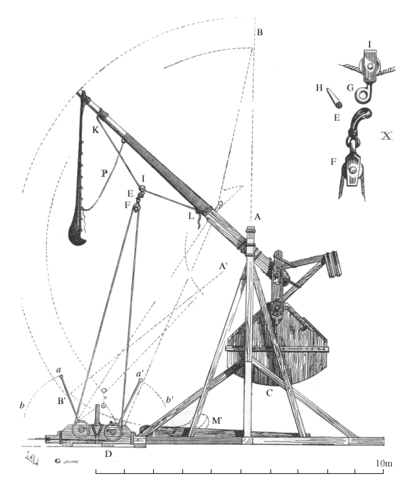
When it comes to catapults the largest and by far most destructive was the counterweight trebuchet.
The counterweight trebuchet began to see action in Europe around the 12th century. This was because at this point cities and castles started to build large and dense walls made of stone. Attacking armies would need a way of safely lobbing heavy projectiles into cities and against walls.
Into this demand came massive catapults called trebuchets. Here a large counterweight weighing several tons would be lifted and suspended in the air. Attached to this counterweight was a large arm that would maximize the velocity of the projectile. At the end of this arm was either a sling or basket that carried the projectile.
The result of this is a catapult that can lob a 300-400 lb projectile around 1,000 ft. The amount of force that these stones would make when hitting walls was enough to break through even the sturdiest of walls. As the medieval era progressed these siege engines would get bigger and larger.
However, setting up these trebuchets took upwards of a week, and as a result, sieges became extremely long and complex processes. Because of this engaging in a siege where trebuchets were needed was a rare sight in the later middle ages.
Conclusion
There you have it, the 3 types of catapults used throughout history.
Catapults are a fascinating piece of military history. The last time a catapult was used in warfare was during WWI when British soldiers used British and French handheld catapults to lob grenades into no man’s land! Today catapults are used on Aircraft carriers to launch fighter jets into the air.
Here at The History Ace, I publish the best history articles on the internet. If you enjoyed this article then consider subscribing to the free newsletter and sharing it around the web.
Further, you can check out some of the other articles below.
-
The 3 Types of Catapults

Catapults used throughout history fall into 3 different types of categories. Here is the history behind and the 3 types of catapults!


